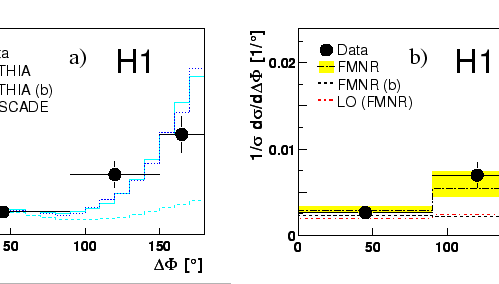ZEUS and H1 have performed analyses of ![]() correlations
[47,48]
in which the
correlations
[47,48]
in which the ![]() is reconstructed in the decay
is reconstructed in the decay
![]() .
The separation of charm and beauty production exploits the charge
and azimuthal angle correlations of the
.
The separation of charm and beauty production exploits the charge
and azimuthal angle correlations of the ![]() meson and the muon.
Four different correlation regions are defined which
are populated differently by charm and beauty events
(see fig.36), thus allowing to separate the cross section
contributions from charm and beauty quark pairs.
meson and the muon.
Four different correlation regions are defined which
are populated differently by charm and beauty events
(see fig.36), thus allowing to separate the cross section
contributions from charm and beauty quark pairs.
In the approximation in which the directions of the ![]() meson and the
muon are identified with those of the quark and antiquark, only one
correlation is possible for
meson and the
muon are identified with those of the quark and antiquark, only one
correlation is possible for ![]() pairs, and the events populate region IV.
In contrast, beauty events populate regions II,III, and IV depending on whether
the muon originates from the same
pairs, and the events populate region IV.
In contrast, beauty events populate regions II,III, and IV depending on whether
the muon originates from the same ![]() quark as the
quark as the ![]() or from the
opposite
or from the
opposite ![]() .
The correlations for the
.
The correlations for the ![]() and the muon
are smeared out by the leptonic decay spectrum and
by fragmentation effects.
Higher order QCD effects like gluon radiation and/or
an initial transverse momentum of the gluon should also be visible.
Possible physics backgrounds come from
and the muon
are smeared out by the leptonic decay spectrum and
by fragmentation effects.
Higher order QCD effects like gluon radiation and/or
an initial transverse momentum of the gluon should also be visible.
Possible physics backgrounds come from
![]() mixing and
Cabibbo suppressed decays
mixing and
Cabibbo suppressed decays
![]() ,
,
![]() .
Experimentally, background contributions originate from events with
fake
.
Experimentally, background contributions originate from events with
fake ![]() mesons, i.e.from combinatorial background, or from fake muons.
mesons, i.e.from combinatorial background, or from fake muons.
Monte Carlo simulations are used to account for smearing effects and backgrounds.
The normalization of the combinatorial background is fitted using right and wrong
charge combinations of the ![]() decays in each region separately.
Here, wrong charge combinations are given by
decays in each region separately.
Here, wrong charge combinations are given by
![]() .
The relative fractions of beauty and charm are then extracted from a fit
to the four correlation regions.
.
The relative fractions of beauty and charm are then extracted from a fit
to the four correlation regions.
The analysis does not depend on the reconstruction of jets and is thus
capable of accessing a kinematic region of lower invariant masses
![]() than the measurements of the beauty cross section
for events with jets in the final state (see fig.37).
than the measurements of the beauty cross section
for events with jets in the final state (see fig.37).
 |
The normalized differential cross section
of the ![]() sample is compared with LO+PS predictions from Pythia and Cascade
(fig.38a)
and with predictions from FMNR at LO and at NLO
(fig.38b).
The data show the expected deviations from the LO calculations due to higher order
effects: the observed
sample is compared with LO+PS predictions from Pythia and Cascade
(fig.38a)
and with predictions from FMNR at LO and at NLO
(fig.38b).
The data show the expected deviations from the LO calculations due to higher order
effects: the observed
![]() peak around
peak around
![]() is broader than the LO
computation. The data are in good agreement with the NLO calculation and also
with PYTHIA and CASCADE.
Although different approaches are used in PYTHIA and CASCADE to compute the
evolution of the partons from the proton and the hard interaction,
the differences between the two simulations are smaller than the
experimental errors.
is broader than the LO
computation. The data are in good agreement with the NLO calculation and also
with PYTHIA and CASCADE.
Although different approaches are used in PYTHIA and CASCADE to compute the
evolution of the partons from the proton and the hard interaction,
the differences between the two simulations are smaller than the
experimental errors.
The visible beauty and charm cross sections as measured using ![]() correlations
by H1 [47] and by ZEUS [48] are compared
with theory predictions. The results are listed in table 4 and
are also shown in fig.40.
Comparison of the measurement with the theory predictions shows that the beauty
cross sections extracted from the
correlations
by H1 [47] and by ZEUS [48] are compared
with theory predictions. The results are listed in table 4 and
are also shown in fig.40.
Comparison of the measurement with the theory predictions shows that the beauty
cross sections extracted from the ![]() data are consistently higher by roughly
a factor 3 to 4 than the expectations from theory.
In contrast, the corresponding charm cross sections are generally well described by theory.
data are consistently higher by roughly
a factor 3 to 4 than the expectations from theory.
In contrast, the corresponding charm cross sections are generally well described by theory.